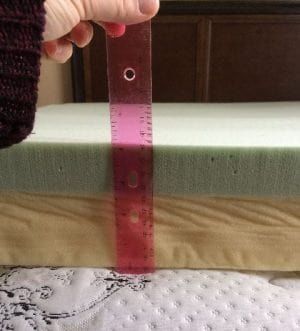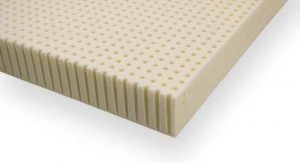As you shop through the many products on the market, what are you looking for? This is a very important question to ask yourself. You’re preparing to make a very large investment, and you’ll be spending many hours of your life on the final product you choose. Do you obsess over aesthetics? Maybe you focus on motion transfer or materials such as latex or memory foam. There’s an important aspect that many overlook that I want to make sure you know the ins and outs of. Indentation load deflection, in a nutshell, represents firmness level, an important aspect that dictates overall comfort.
You probably didn’t think you could get an idea of firmness without feeling the mattress for yourself. Now, this concept is a little complicated, and that’s why I’m going to break it down for you so you can use this scientific way of measuring firmness. Your knowledge can help you make an educated and informed decision about the mattress you ultimately decide to make the investment in.
Origins: ILD vs. IFD
It’s entirely possible that you’ve already come across acronyms such as ILD and IFD, and there often isn’t much explanation as to the specifics of what they mean. Or, on the other end of the spectrum, you may find yourself overwhelmed with confusing information and mathematical models that leave you scratching your head and wondering if you should give up your online shopping endeavors and start driving from town to town in search of the best mattress. Don’t give up just yet! You can understand this concept, and it’s best to start at the root. So, let’s jump into the origin!
That Darn Metric System
It can be easy to allow the metric system to throw you for a loop. When talking mattresses, you likely thought you had escaped its reaches. However, it’s because of the metric system that you see the two acronyms ILD and IFD.
The good news is that it’s nothing too complicated to wrap your mind around. The firmness of your mattress is measured by a physical property known as indentation force deflection. Yes, the name sounds intimidating, and we’ll make it more clear in a moment. But, first, let’s clearly differentiate indentation force deflection from indentation load deflection.
The Polyurethane Foam Association takes you through a clear timeline of just what happened, and it’s not as scary as it may sound. Americans have long rejected the metric system, and this can be traced back to Thomas Jefferson. According to Time magazine, it was his opinion that this system was “too French.” Even though he actively participated in the establishment of the U.S. dollar, the first fully-decimal measured currency used by any nation, an aversion for the metric system with American culture persisted.
There was a push in the 1970’s to conform with most other parts of the world and begin adopting the use of the metric system, and it was during this time that the American Society of Testing and Materials made the decision to conform in all of their publications and measurements. (If you’re feeling overwhelmed, keep in mind that one of our Mars probe missions failed because of the misunderstanding between the European Space Agency and NASA over metric conversions, so it gets confusing.) It was this decision that prompted them to cease the use of the word “load” and replace it with “force.” Aside from this minor change in name, the two testing methods are otherwise basically identical. See, I told you it wasn’t that complicated!
How Indentation Load Deflection is Tested
As we delve into the specifics of indentation load deflection, first take yourself back to one of your high school science classes. It’s necessary to have controls, and this allows us to make experiments relevant and avoid comparing apples to bananas. For example, if I were to test the heat retention of my mattress using thermal imaging after applying heat for five minutes and conclude that it returns to room temperature after three minutes, it wouldn’t be fair to test another mattress after laying on it for 30 minutes. This would make the second mattress appear to take far longer when, in fact, it could very well be superior. Because of this inconsistency, we are unable to make an accurate comparison.
What Exactly Is Indentation Load Deflection?
Indentation Load Deflection is a measurement in firmness level. The higher the number, the more firm it is and vice versa for lower numbers.
When measuring ILD, there have been standards put in place that the industry uses to ensure you have a clear idea of just what the numbers represent. To test, a foam sample of material measuring 15 inches x 15 inches x 4 inches is used. A 50 square inch circular indenter is used to compress the material a total of 25 percent of its thickness. So, with that being said, I want to make sure you’re not overwhelmed with numbers. Take a moment to check out this video. It clearly shows the process as well as the computerized measurements that result which allow for precise results you can count on.
— Putting Things Into Perspective
When considering firmness, your body force exerted on the mattress is synonymous with the circular indenter. Depending on your body type, you’ll have different points of pressure, primarily in your hips and buttocks. Since everyone is different, the ILD test helps to allow for a general impression of what you can expect when applying your full body weight on your mattress. Now, you may be wondering, “What if I weigh more/less than the amount of force necessary to compress the material 25 percent?” This takes us back to standards and conformity. If there were specified tests for every body type, it would be difficult for a manufacturer to list their ILD ratings for consumers to take advantage of. However, you know your weight, so it’s up to you to use these ratings and apply them to your unique circumstances.
— Considering the Variables

— Material Thickness
As the material thickness increases, so does the ILD value. It’s important to understand that each foam type varies, so if you come across generalized estimates, you can’t very well rely on them. This is because the ILD rating to thickness change ratio has to be determined for each type of material. The following table is a sample testing on foam material. While this chart does not serve to represent all mattress types, it offers a great guide to help you better understand how mattress thickness impacts ILD ratings.

4—————————29.0
5—————————32.0
6—————————35.5
7—————————39.5
8—————————44.0
Now, let’s take a moment to review this chart to help you understand the variance here that must be considered. When you move from four to five inches on this sample thickness, the ILD value increases by exactly three lbs/50 in². However, when you move from five to six inches, the ILD value increases to 3.5 lbs/50 in². This trend continues to increase the further the sample thickness increases. It’s a logarithmic scale.
Why the Variance on the Same Material?
If you’re left scratching your head as to why this level of variance exists on the same material, you have to consider the effect of the thickness when the ILD value is higher. Basically, it becomes compounded. This is because, when you increase the thickness, the indenter has to push down on the bed deeper.
For example, a four inch thickness requires a one inch depression to reach 25 percent. When you advance to a five inch thickness, the indentation increases to 1.25 inches. To put this into perspective, imagine you order a small pizza measuring eight inches in diameter. You could probably eat 25 percent of it with no problems. However, if you increase the size to 16 inches, 25 percent consumption would be much more difficult to achieve as you .are compressing more food in your stomach. The larger the pizza, the more effort you’ll have to put into reaching that 25 percent threshold. Just as your body has to gradually work harder to accommodate the pizza, the indenter has to work harder to match 25 percent indentation on thicker material.
Depending on the particular material you’re working with, the force required to meet these parameters will differ. Back to the pizza example, think of the differences. You can likely eat more of a thin-crust cheese pizza than a thick-crust, fully-loaded option.This real-life example shows you how important it is to make sure you are comparing apples to apples when you analyze firmness testing results. Thickness levels matter.
— Temperature and Humidity
Temperature and humidity have a direct impact on the ILD rating, and this is true from the moment the foam is poured into the mold. Something many consumers are unaware of is the concept of “summertime ILD regression.” In a nutshell, firmness levels decrease in the summertime. When you think about it, it’s not that surprising. Consider other materials, for example, metals. When they are heated up, they soften. Although we are considering foam, we can use the ideal gas law equation of PV = nRT.
Now, in this equation, we are primarily concerned with P (pressure) and T (temperature). Without getting into a full-blown thermodynamics lesson, this law dictates that an increase in temperature correlates with an increase in volume. With that being understood, we can then consider the density equation, which is, quite simply put, mass/volume. When volume rises, the material becomes less dense. Ergo, the material becomes softer.
• Formula Adjustments Are Made
If you’re feeling a little overwhelmed, that’s okay. After all, you’re looking for the best foam mattress, not a degree in physics, right? It’s worth noting that manufacturers do make adjustments to their formulas to consider these seasonal changes. However, the temperature and humidity variance is worth noting because each manufacturer considers their formula changes based on their own experiments and data. Once the mold is poured, the resulting material is irreversible.
• Memory Foam Changes in Response to Body Heat
One more note on temperature. When dealing with memory foam, you must keep in mind that it’s naturally designed to respond to body heat, and you should expect your ILD to decrease when you’re laying on it. In other words, your mattress will soften as you fall asleep. If this is an issue for you, there’s something you can be on the lookout for when you shop: the temperature range in which the material reportedly responds to. Some are made that don’t respond until the temperature reaches a certain level. If these levels are higher than what your body is capable of generating, say 150 degrees F, you can expect the stated ILD to be what you can experience consistently regardless of time spent on the mattress during a single session.
— Manufacturer and Foam Type
Another important variable to consider is the manufacturer and type of foam. While the industry is highly regulated, there are still many aspects that are dependent on the manufacturer such as their location, industrial standards, their processes and what type of material they are using. For example, as we covered in temperature and humidity, we learned that memory foam responds differently than, say, latex.
Furthermore, minor changes can make a difference in one batch to the next even when you’re dealing with the same manufacturer and foam type. While these changes are slight, they do exist. Imagine you were making two pans of XYZ Brand brownies. Each has the exact same recipe and instructions, but there are many things that could impact the consistency of the two end products.
Perhaps you put in slightly less oil in the second batch. Maybe the egg size was a little larger in the first. The oven may had had more time to heat up by the time you put in the second batch.Or maybe you got a phone call when you were supposed to take a batch out and it stayed in an extra minute or two. It’s unlikely that one brownie is going to be noticeably tastier than the other, but it’s worth noting that these variances exist.
Just as there are tolerances for variance when you make brownies, they also exist when it comes to the production of foam. For any given batch, just a few to keep in mind include:
- Production pumps
- Temperature controls
- Changes made by engineers and foam chemists
- Mixing equipment
Differences for Weight Changes and Compression Modulus
We touched briefly on the fact that your individual weight makes a differences on how you perceive firmness, but let’s take a moment to delve a little deeper into the subject. As far as weight is concerned, it’s clear that, the more you weigh, the deeper you’re going to sink into the material. Your weight is comparable to the indenter used for ILD testing. The deeper you sink into the mattress, the firmer it becomes due to the increase in compression. This is known as the material’s compression modulus, and different foams increase in firmness due to this factor at different rates.
A great example of compression modulus variation can be found when comparing Talalay latex with Dunlop latex. Even though the difference in the manufacturing of these two materials is slight, consumers stand to experience substantial differences when it comes to firmness levels. In Talalay, it requires three times the weight to make a 65 percent indentation compared with a 25 percent indentation. For Dunlop latex, on the other hand, this difference in force is four times as great. Ergo, for anyone with a weight that would cause an indentation larger than 25 percent, Dunlop will feel firmer regardless of the ILD rating provided.
Latex vs Foam ILD and the Differences in How They are Measured

When you think about it, this means that, when working with latex, you get the benefit of an additional half inch of compression when compared with polyfoam testing. With a basic understanding of the variance that thickness presents, it’s clear that it’s impossible to make an accurate comparison when one thickness is greater than another. Therefore, if you’ve narrowed down your choices between a latex and polyfoam mattress, your best bet is to actually sample lying on each mattress to see which is most comfortable for you.
Putting it All Together
It’s clear that there’s much more to ILD ratings than just a number. So, just what does all this mean? Is it pointless to even consider ILD as part of your shopping? Definitely not. These ratings do have general standards that can help you compare your options. For instance, if you found two comparable products, one with a rating of eight and another with a rating of 14, you can generally expect that the 14 rating will offer a firmer experience. However, when rating levels are similar, then there are many other factors that must be taken into consideration.
It’s also worth understanding ILD ratings so that, if you do visit a storefront, fast-talking salesman won’t be able to pull a fast one on you assuming your ignorance. Instead, you can enter the situation with an understanding of how the ratings can be manipulated to make something sound better than it may actually be.
Shop Smart, Choose Right
It’s my goal that you’re able to maximize the quality of your shopping experience and find the mattress that will offer maximum comfort for your needs. I hope you learned a thing or two about indentation load deflection from this comprehensive list, and I’d love to hear your thoughts. If there are further components of this measuring system you want to know or comments you’d like to share based on your experiences, I’d love to hear them! Please feel free to share them below. Also feel free to share this information so we can help spread the knowledge and make others aware of how to make the best mattress purchase possible.



